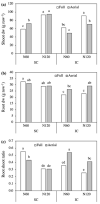The Importance of Root Interactions in Field Bean/Triticale Intercrops
- PMID: 33147896
- PMCID: PMC7693349
- DOI: 10.3390/plants9111474
The Importance of Root Interactions in Field Bean/Triticale Intercrops
Abstract
To highlight the contribution of belowground interactions to biomass and N and P yields, field bean and triticale were grown in a P-poor soil as sole crops and as replacement intercrops at two N levels. The shoots were always in contact, while the roots of adjacent rows were free to interact or were completely separated. This allowed simultaneous testing the intraspecific and interspecific competition between rows, which to our knowledge has not been studied before. Root biomass, distribution in soil, morphometry, and functional traits were determined, together with the nodule number and biomass. The Land Equivalent Ratio for shoot biomass and N and P yield were higher than 1 when roots were in contact, and markedly lower when they were separated. This demonstrates the positive contribution of root interactions, which in field bean, consisted of increased root elongation without changes in biomass and nutrient status; in triticale, of increased N and P uptake efficiency and reduced biomass partitioning to roots. The soil-plant processes underlying intercrop advantage led to complementarity in N sources with low N inputs and facilitated N and P uptake with high N inputs, which demonstrates that intercropping could be profitable in both low and high input agriculture.
Keywords: N level; P facilitation; field bean; intercrops; legume/cereal; nodule; root interactions; root morphometry; soil enzyme activity; triticale.
Conflict of interest statement
Authors declare there is no conflict of interest.
Figures









References
-
- Duchene O., Vian J.F., Celette F. Intercropping with legume for agroecological cropping systems: Complementarity and facilitation processes and the importance of soil microorganisms. A review. Agric. Ecosyst. Environ. 2017;240:148–161. doi: 10.1016/j.agee.2017.02.019. - DOI
-
- Bybee-Finley K., Ryan M. Advancing intercropping research and practices in industrialized agricultural landscapes. Agriculture. 2018;8:80. doi: 10.3390/agriculture8060080. - DOI
-
- Wezel A., Casagrande M., Celette F., Vian J.F., Ferrer A., Peigné J. Agroecological practices for sustainable agriculture. A review. Agron. Sustain. Dev. 2014;34:1–20. doi: 10.1007/s13593-013-0180-7. - DOI
Grants and funding
LinkOut - more resources
Full Text Sources

